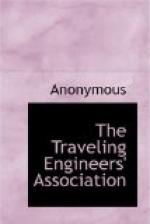57. Q. Explain the operation of this compressor.
A. When steam is first turned on, it enters the compressor at the steam inlet (see Fig. 4) and flows through passage “a” into the reversing valve chamber “C” and on to chambers “b” and “y” against the inner faces of the differential pistons, causing the main valve to move to the right. In this position of the main valve, port “g” is open to chamber “b”, thus admitting live steam to the lower end of the high pressure steam cylinder, causing an upward movement of the piston 7. When the piston 7 has nearly completed its up stroke, the reversing plate 18, which is attached to the top of this piston, comes in contact with a shoulder on the reversing rod 21, forcing it upward, carrying with it the reversing valve 22, the movement of which closes port “m”, at the same time opens port “n”, filling chamber “D” with live steam from chamber “C” and passage “a”. This balances the pressure on the two sides of the large piston of the differential pistons, and the pressure acting against the inner side of the small piston causes the main valve to move to the left (see Fig. 5). The main valve moving to the left closes port “g” to the live steam and at the same time connects this port with port “f” leading to the lower end of the low pressure steam cylinder, causing an up stroke of the low pressure steam piston 8. In the meantime port “c”, which leads to the upper end of the high pressure steam cylinder, is open to chamber “y”, allowing live steam to flow down on top of the high pressure steam piston 7, forcing it downward. As the high pressure steam piston about completes its downward stroke, the reversing plate 18 engages the button on the lower end of the reversing rod 21, pulling the rod and reversing valve 22 down, closing port “n” and at the same time connecting port “m” and “l” through the exhaust cavity “q”, thus allowing the steam in chamber “D” to escape to the exhaust. The pressure being removed from the outer face of the large differential piston, the main valve will again move to the right, opening port “g”, admitting live steam beneath the piston 7, and at the same time connecting the upper end of the high pressure steam cylinder through port “c”, chamber “h” and port “d” to the upper end of the low pressure steam cylinder, causing a downward movement of the low pressure steam piston; the steam below this piston will now be free to escape to the exhaust through port “f”, chamber “i” and port “e”. Thus it will be seen that the steam used in the high pressure steam cylinder is live steam from the boiler, while the steam used in the low pressure steam cylinder is the exhaust steam from the high pressure steam cylinder.
58. Q. Explain the operation of the air end of the compressor.




